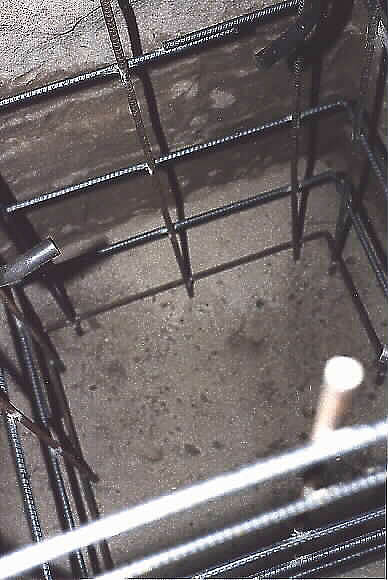
Dig the footing to specifications and the lower rebar cage into place.

Dig the footing to specifications and the lower rebar cage into place.
The hole is 3' x 3' x 6 1/2' deep. The rebar cage is constructed to UBC and local building code requirements. This rebar cage is welded together, but local codes often allows the members to be wired together with bailing wire. Although some local building codes do not require it, the cage should be placed on top of 3" cement piers so that the bottom end of the cage will be completely embedded within the concrete. The top end is 3" to 6" below the top surface of the concrete. The rebar cage must be imbedded in at least three inches of concrete on each side; therefore, the top view dimensions of the cage are 2 1/2 x 2 1/2' to allow the necessary clearance in the 3 x 3' hole. The vertical spacing of the square horizontal members are specified in local building codes and may differ from the UBC standards in some jurisdictions. It is therefore, very important that you verify the rebar requirements with your local building department.
Unless you have both the tools and experience working with rebar, you should subcontract this part of the job to a local steel supply company. This size cage delivered to the site should cost around $150.
If you choose to save money by digging your own hole, be prepared for allot of back breaking work. When I dug my own at the old house it took three weeks. Weekends from dawn to dusk plus weekdays from the time I got home from work to sundown. The soil at the old house was compacted sand and clay. One of the biggest problems for someone with limited experience is keeping the sides straight and digging vertically in a cramped space where the shovel handle is often too long. I found a post hole digger very handy in that regard.
Because of access problems and the proximity to the swimming pool, the hole you see here was also hand dug, but it took an experienced crew only one day! So which do you prefer? One day and a few bucks or weeks of endless pain!